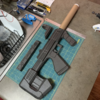einherjarvalk
New Member
Hi all,
Long time lurker, first time poster. I've had my eye on doing Halo cosplay for years but the cost and scale of the work necessary has put me off for a long time. My new year's project this year is to overcome that and eat this particular elephant one bite at a time, with the intent of eventually having a wearable ODST cosplay by this fall. While I'm not a stranger to making armor (I've done some small armor pieces and props with foam and Worbla for a few other cosplays that were much more fabric-intensive), this will be my first time using Pepakura templates of any sort. I've decided to start by making a weapon of some sort to get my bearings using pep templates before moving on to armor pieces and then, finally, the helmet.
Right now I've pulled the pep files from the Armory for Halo 3: ODST's armor and weaponry, but I'm having a bit of trouble making sense of it all. There's some files labeled "FOAM" as well as "A" or "B", but they often don't seem to have all the parts matching to the file; some of the parts are outside of the "print" format. Am I supposed to use both A and B templates for things like the M7S or just one or the other?
I've been poking around at Reach files as well in case I decide to go for the more detailed Reach ODST look, but there appears to be multiple cases of A/B files with missing parts for the major weapons (MA37, M392) as well, and I haven't found any ODST .zips for Reach either (I'm guessing the Reach set is a mish-mash of UNSC Marine/Army trooper and Spartan-III parts).
Any guidance that might be helpful? I realize it may be cheaper and more effective to just buy things like weapon props, but I want to start small and have the satisfaction of saying "yes I made these" when I go out in public with them if possible. Additionally, does anyone have experience using thermoplastics like Worbla to "coat" foam Halo armor? I've done it before for Fire Emblem pauldrons but I'm not sure if the finer details of Halo pieces may make it suboptimal.
Long time lurker, first time poster. I've had my eye on doing Halo cosplay for years but the cost and scale of the work necessary has put me off for a long time. My new year's project this year is to overcome that and eat this particular elephant one bite at a time, with the intent of eventually having a wearable ODST cosplay by this fall. While I'm not a stranger to making armor (I've done some small armor pieces and props with foam and Worbla for a few other cosplays that were much more fabric-intensive), this will be my first time using Pepakura templates of any sort. I've decided to start by making a weapon of some sort to get my bearings using pep templates before moving on to armor pieces and then, finally, the helmet.
Right now I've pulled the pep files from the Armory for Halo 3: ODST's armor and weaponry, but I'm having a bit of trouble making sense of it all. There's some files labeled "FOAM" as well as "A" or "B", but they often don't seem to have all the parts matching to the file; some of the parts are outside of the "print" format. Am I supposed to use both A and B templates for things like the M7S or just one or the other?
I've been poking around at Reach files as well in case I decide to go for the more detailed Reach ODST look, but there appears to be multiple cases of A/B files with missing parts for the major weapons (MA37, M392) as well, and I haven't found any ODST .zips for Reach either (I'm guessing the Reach set is a mish-mash of UNSC Marine/Army trooper and Spartan-III parts).
Any guidance that might be helpful? I realize it may be cheaper and more effective to just buy things like weapon props, but I want to start small and have the satisfaction of saying "yes I made these" when I go out in public with them if possible. Additionally, does anyone have experience using thermoplastics like Worbla to "coat" foam Halo armor? I've done it before for Fire Emblem pauldrons but I'm not sure if the finer details of Halo pieces may make it suboptimal.


